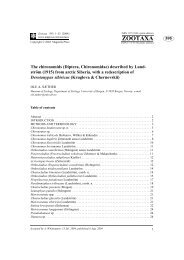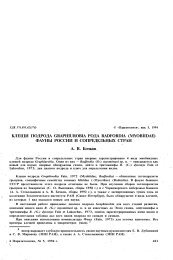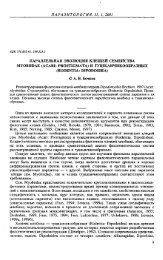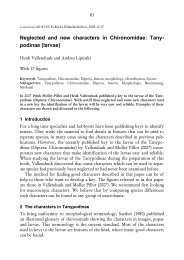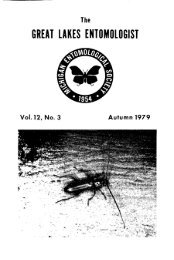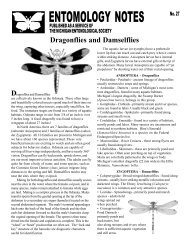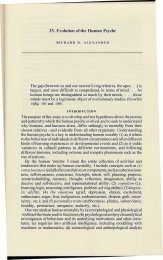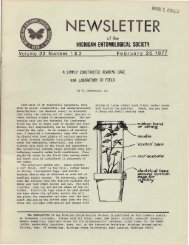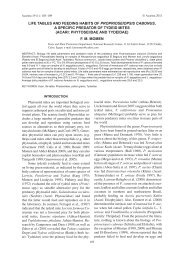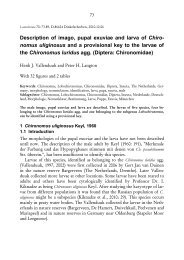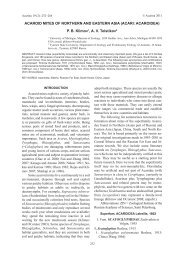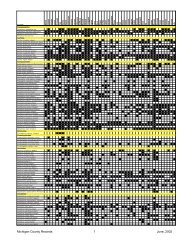Chironomus newsletter on Chironomidae research 22
Chironomus newsletter on Chironomidae research 22
Chironomus newsletter on Chironomidae research 22
You also want an ePaper? Increase the reach of your titles
YUMPU automatically turns print PDFs into web optimized ePapers that Google loves.
L<strong>on</strong>d<strong>on</strong>, The Natural History Museum La Plata,<br />
The Institute of Limnology La Plata, The<br />
University of Patag<strong>on</strong>ia in Esquel, The Central<br />
Regi<strong>on</strong>al University at Bariloche and the Nati<strong>on</strong>al<br />
Parks Administrati<strong>on</strong> Bariloche.<br />
A key task for the team is to study the major<br />
freshwater insect groups in NHNP including<br />
Chir<strong>on</strong>omidae, Ceratopog<strong>on</strong>idae and Simulidae<br />
(Diptera); Plecoptera; Ephemeroptera; Od<strong>on</strong>ata;<br />
Trichoptera; and aquatic Coleoptera. With<br />
invaluable logistics support from the park rangers<br />
and other NHNP staff, more than 200 sites have<br />
been sampled covering the various freshwater<br />
envir<strong>on</strong>ments represented in NHNP. The<br />
sampling methods included Malaise trap, light<br />
trap, sweep net, drift net and kick sample.<br />
Tax<strong>on</strong>omic, ecological and distributi<strong>on</strong>al data<br />
resulting from this collecting effort is being<br />
entered into a database of freshwater insects from<br />
NHNP. The species distributi<strong>on</strong> data will be<br />
linked to a vegetati<strong>on</strong> classificati<strong>on</strong> and the<br />
physical and chemical attributes of the water<br />
bodies, using GIS and digital imaging, and will be<br />
used to model freshwater insect data spatially and<br />
create a biodiversity data repository, the first of<br />
its kind in Patag<strong>on</strong>ia. Another important project<br />
goal was addressed by building infrastructure in<br />
NHNP to provide a wetland interpretati<strong>on</strong> centre<br />
and laboratory where tourists, sport anglers,<br />
students and <strong>research</strong>ers can study freshwater<br />
insects and understand their role in freshwater<br />
ecosystems.<br />
Patag<strong>on</strong>ian chir<strong>on</strong>omid fauna<br />
The first records and knowledge of Chir<strong>on</strong>omidae<br />
from Patag<strong>on</strong>ia are due to the invaluable work of<br />
the English entomologist Frederick Wallace<br />
Edwards (1888-1940). To obtaining collecti<strong>on</strong>s of<br />
insects from the southern Andes, a joint<br />
expediti<strong>on</strong> was arranged in 1926 by the British<br />
Museum of Natural History and the<br />
Bacteriological Institute of the Nati<strong>on</strong>al<br />
Department of Hygiene of Argentina. Edwards<br />
went to collect for the British Museum and Mr.<br />
Raym<strong>on</strong>d C. Shann<strong>on</strong> for the Argentine<br />
Government. At the end of the field trip, they<br />
collected collecti<strong>on</strong>s of over 20000 insects each<br />
<strong>on</strong>e (Edwards 1927). After the study of the<br />
material collected, Edwards published in 1931<br />
published the chapter referred to Chir<strong>on</strong>omidae as<br />
a part of the book “Diptera of Patag<strong>on</strong>ia and<br />
South Chile” and he described 71 new species<br />
and gives the foundati<strong>on</strong> of the chir<strong>on</strong>omid<br />
Patag<strong>on</strong>ian knowledge.<br />
Preliminary data <strong>on</strong> Chir<strong>on</strong>omidae collected<br />
during the project, supplemented by examining<br />
10<br />
collecti<strong>on</strong>s made by earlier entomologists and<br />
literature searches, has shown that the chir<strong>on</strong>omid<br />
fauna of NHNP includes 104 species in 48 genera<br />
and 6 subfamilies. Analysis of subfossil larvae<br />
from lake sediments collected in NHNP include<br />
52 morphotypes in 36 genera and 4 subfamilies<br />
(D<strong>on</strong>ato et al. 2008). The number of chir<strong>on</strong>omid<br />
species found in NHNP c<strong>on</strong>stitutes a relatively<br />
high proporti<strong>on</strong> of the chir<strong>on</strong>omid diversity of<br />
Patag<strong>on</strong>ia. Nine subfamilies are recorded from<br />
this regi<strong>on</strong>, including the m<strong>on</strong>otypic subfamily<br />
Chilenomyiinae which is endemic for the area.<br />
Of the 111 known genera from South America,<br />
53 are present in the study area. Approximately<br />
20 % of the genera recorded from Patag<strong>on</strong>ia are<br />
endemic to the regi<strong>on</strong>. One hundred and seventy<br />
seven species of Chir<strong>on</strong>omidae have been<br />
recorded from Patag<strong>on</strong>ia, 98% of them are<br />
endemic, 3 % are c<strong>on</strong>sidered nomina dubia and<br />
about 17 % require revisi<strong>on</strong> since their systematic<br />
positi<strong>on</strong> is doubtful. Taking the Andean cordillera<br />
as a boundary, 55 species are endemic to the<br />
eastern side, 57 are endemic to the western side<br />
and 65 are comm<strong>on</strong> to both sides. The original<br />
descripti<strong>on</strong>s of the chir<strong>on</strong>omid species from<br />
Patag<strong>on</strong>ia are based mainly <strong>on</strong> males (n=58) or<br />
males and females (n=43) which represents 57 %<br />
of the total. The rest of the species have been<br />
described using different combinati<strong>on</strong>s of stages<br />
from their life cycle (D<strong>on</strong>ato et al., 2009). The<br />
Patag<strong>on</strong>ian chir<strong>on</strong>omid fauna shows affinities<br />
with the Australasian regi<strong>on</strong> (i.e. with a strict<br />
transantarctic distributi<strong>on</strong>) exemplified by the<br />
Chir<strong>on</strong>ominae genera Megacentr<strong>on</strong> Freeman and<br />
Riethia Kieffer, the Pod<strong>on</strong>ominae genus<br />
Rheochlus Brundin, and the Orthocladiinae<br />
genera Austrocladius Freeman, Botryocladius<br />
Cranst<strong>on</strong> & Edwards, Parapsectrocladius<br />
Cranst<strong>on</strong>, Rhinocladius Edwards and<br />
Stictocladius Edwards. Based <strong>on</strong> the material<br />
collected, mounted and studied so far during the<br />
last three years, we have found 16 new species<br />
that are waiting for more data (mostly c<strong>on</strong>cerning<br />
their immature stages) before they are described.<br />
References<br />
Cabrera, A.L. & Willink, A. 1973. Biogeografía<br />
de América Latina. M<strong>on</strong>ografía 13. Serie de<br />
Biología. Secretaría General de la<br />
Organización de los Estados Americanos.<br />
Washingt<strong>on</strong> DC. USA. 120 pp.<br />
D<strong>on</strong>ato, M., Massaferro, J. & Brooks, S.J. 2008.<br />
Chir<strong>on</strong>omid (Chir<strong>on</strong>omidae: Diptera)<br />
checklist from Nahuel Huapi Nati<strong>on</strong>al Park,<br />
Patag<strong>on</strong>ia, Argentina. Revista de la Sociedad<br />
Entomologica Argentina 67: 163-170.



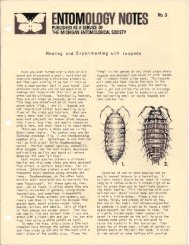
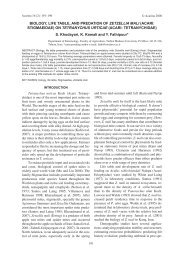
![Williamsonia 1-1 [v4.0] (DR) - Insect Division - University of Michigan](https://img.yumpu.com/18248489/1/190x245/williamsonia-1-1-v40-dr-insect-division-university-of-michigan.jpg?quality=85)
